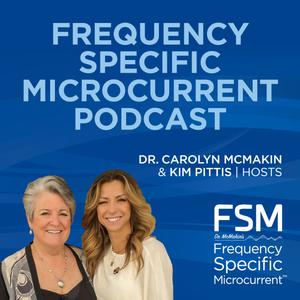
Frequency Specific Microcurrent Podcast
Dr. Carol & Kim Pittis
- 56 minutes 35 seconds145 - FSM, Epigenetics, and Patient Empowerment
In this episode, we journey through a series of inspiring stories and expert discussions about the power of healing through innovative medical techniques and patient care strategies. Witness a heartwarming reunion that turns into a deep dive into Frequency Specific Microcurrent (FSM), exploring its profound impact on patients with severe pain and chronic conditions. Learn from compelling case studies and expert insights on pain management, mental health, and the role of language in treatment. Discover the transformative potential of epigenetics and mind-body therapies, and how patients can take control of their healing processes. Join us for engaging conversations, practical advice, and real-life examples of how collaboration, adaptability, and continuous learning can lead to breakthroughs in medical practice and patient outcomes.
00:00 Reunited and It Feels So Good
02:16 The Power of Flexibility and Adaptation
03:36 Creative Solutions and Improvisations
04:02 The Legacy of Netter's Medical Illustrations
04:51 A Heartfelt Reunion
05:16 Overseas Adventures and Insights
05:29 The Joy of Continuous Learning
06:19 FSM: Simple Fixes for Complex Problems
06:40 A Case Study: Chronic Pain and Innovative Treatments
21:54 The Importance of Words in Healing
24:38 Dupuytren's Contracture: A Deep Dive
28:50 Connecting the Dots in FSM
29:43 Learning from Patterns and Advice
30:22 The Importance of Collaboration
31:02 Rapid Results and Client Safety
31:23 Challenges in Treating Dupuytren's Contracture
36:36 Understanding Tendinopathy
45:27 Empowering Patients with Knowledge
53:25 Upcoming Symposium and Final Thoughts
Epic Advice: What You Need Shows Up
It’s crucial to trust that what we need will eventually manifest, albeit in unexpected forms. Herein lies an epic piece of advice shared—embracing this mindset alleviates anxiety for those with type-A personalities, encouraging a survival kit of adaptability in ever-changing environments.
Healing Beyond Boundaries: The Magic of FSM
In the core of this discussion lies the heart of Frequency Specific Microcurrent (FSM) therapy. Kim passionately talks about its magic—the swift relief it brings to complex physical ailments that seem eternal and its ability to change lives one patient at a time. Through real case stories, she illustrates how a simple shift in approach can unearth significant changes. FSM offers a reprieve and hope for those suffering chronic pain, teaching practitioners to respect its rapid outcomes and adapt strategies for lifelong benefits.
Diving Into Case Studies: An FSM Journey
The symptoms and stories of various patients, including a gripping account of managing Dupuytren’s contracture, highlight the power of FSM. Practitioners who faced curse-like chronic ailments saw light through this revolutionary therapy. Highlighting detailed case reports, Kim explains breakthroughs achieved with FSM, signifying its pivotal role in modern medical practices.
These case studies reflect the intertwining of knowledge, skill, and innovation that FSM supports, uncovering connections unseen in conventional treatments. They reiterate the FSM mantra: "think in three dimensions" to implement successful healing journeys.
Words Hold Power: Changing Narratives for Better Healing
Kim emphasizes the importance of changing nomenclature in practice, accentuating how the words we use can impact patient mindsets and outcomes. Renaming 'concussion' to a more neutral term like 'Brain Balance' to alleviate anxiety is one such example. Words can invoke different emotions; the right language prepares the body and mind for healing.
Harnessing Internal Power: Mantras and Epigenetics
Mantras like "I am safe," "This feels strong," and "Movement feels good" were highlighted as transformative tools fostering emotional safety during treatments. Delving into the realm of epigenetics, the speakers shared insights into how the environment affects genetic expression, showing promising ways to empower patients with autoimmune diseases to change their narratives.
Honoring the Journey
At the essence of FSM lies a powerful message—each patient deserves happiness and healing. Healing isn't just freeing one from pain; it's about elevating the entire life experience and understanding that we are all integral parts of a bigger picture with our stories interlinking in the vast tapestry of life.
FSM continues to unlock doors to miraculous recovery, not by magic but through steadfast learning, compassionate patience, and creative problem-solving. Each session is a tribute to selfless purveyance among practitioners and the shared mission of changing lives, one patient at a time.
23 October 2024, 9:00 am - 51 minutes 21 seconds144 - David Musnick and Kim Pittis: Insights on Autoimmunity and Frequency Specific Microcurrent
Autoimmune conditions are a significant health issue, often shrouded in mystery and confusion. The recent Frequency Specific Microcurrent (FSM) podcast episode featuring Dr. Musnick, hosted by Kim Pittis, offers a wealth of knowledge on potential causes, management strategies, and the role of frequency-specific microcurrent therapy. This blog post distills key points from the discussion to provide a comprehensive understanding of autoimmunity and empowering patients to take charge of their health.
00:43 Autoimmunity and Sleep
04:10 Predictive Antibodies and Screening
10:18 Causes of Autoimmune Conditions
15:50 Food Allergies and Testing
16:49 Chronic Infections and Autoimmunity
23:17 Managing Autoimmune Conditions
33:46 Positive Affirmations and Imagery
47:24 Telemedicine and Licensing
49:19 Conclusion and Final Thoughts
50:57 Introduction and Gratitude
51:23 Discussing Autoimmunity and Sleep
54:51 The Importance of Antibody Screening
01:01:04 Causes and Prevention of Autoimmune Conditions
01:06:50 Food Allergies and Testing
01:07:44 Infections and Autoimmunity
01:17:24 Managing Autoimmune Conditions
01:24:58 Positive Imagery and Healing
01:38:54 Telemedicine and Licensing
49:21 Conclusion and Gratitude
50:46 Introduction and Podcast Overview
51:23 Discussing Autoimmune Topics
52:05 Importance of Sleep and EMF Exposure
54:17 Autoimmune Screening and Antibody Testing
01:01:10 Causes and Triggers of Autoimmune Conditions
01:06:50 Food Allergies and Intestinal Permeability
01:07:44 Chronic Infections and Autoimmunity
01:20:42 Stress, Sleep, and Autoimmune Flares
01:24:58 Positive Imagery and Affirmations in Healing
01:39:07 Telemedicine and Licensing
Understanding Autoimmunity and Its Causes
In the conversation, Dr. Musnick emphasized that many autoimmune conditions could be traced back to various causes, including infections, toxic burdens, and genetic predispositions. Toxicity, including exposure to mold biotoxins, plays a significant role in triggering immune responses that mistake body tissues for foreign threats.
Another critical factor discussed is the concept of barrier dysfunction, particularly intestinal permeability, commonly known as "leaky gut." This condition can lead to a cascade of immune responses, contributing to autoimmune disorders. Interestingly, Dr. Musnick highlighted that leaky gut itself is an autoimmune disorder, often associated with the gut's exposure to harmful substances like glyphosate in genetically modified foods.
The Role of Infections and Stress
Chronic infections such as Lyme disease and reactivated viral infections are highly correlated with autoimmune conditions. Dr. Musnick stressed the importance of screening for these infections as a preventative measure. Additionally, he pointed out that stress and lack of sleep are profound triggers for autoimmune flare-ups. Patients experiencing prolonged stress should be aware of its potential impact on their immune health.
Diagnostic Approaches
Dr. Musnick recommended getting comprehensive antibody screening to detect autoimmunity early, even before symptoms develop fully. Labs such as Cyrex offer extensive panels that can identify predictive antibodies for both the body and the brain. These tests provide invaluable insights, guiding patients and practitioners in taking preventative steps.
Moreover, he highlighted the need for detailed food allergy panels, considering both IgE and IgG allergies, to tailor dietary adjustments effectively.
Managing Autoimmune Conditions with Frequency Specific Microcurrent
FSM emerges as a promising therapeutic tool for treating the symptoms and triggers of autoimmune conditions. By targeting specific frequencies, FSM helps in modulating the immune system, healing barriers like the blood-brain barrier, and addressing toxic burdens.
Dr. Musnick also highlighted the importance of empowering patients with positive imagery and affirmations during FSM therapy sessions, envisioning a life free from disease constraints and focusing on healing. This psychological aspect is crucial for fostering a conducive environment for recovery.
Empowerment Through Knowledge and Positive Thinking
Labeling oneself with a disease can hinder healing. Dr. Musnick stressed that the identity associated with diagnosis could be limiting. Encouraging patients to view symptoms as temporary and manage them positively can significantly improve outcomes. This approach aligns with the functional immunology framework, where controlling triggers and balancing the immune system take precedence over merely treating symptoms.
16 October 2024, 8:00 am - 56 minutes 28 seconds143 - Sleep Apnea And Its Impact on Health With Dr. Sosnowski
In this episode, Kim Pittis has an in depth conversation with Dr. Jennifer Sosnowski where they explore the critical role of sleep in overall health, focusing on sleep apnea's impact on both chronic illness and athletic performance.
They discuss how sleep apnea affects breathing and sleep cycles, leading to disrupted deep and REM sleep, essential for brain detoxification and memory consolidation. Various methods of diagnosing and treating sleep apnea are examined, such as oral appliances, CPAP machines, and new technologies using sound frequencies. The conversation also covers the implications of sleep quality on autoimmune diseases and stress, emphasizing practical steps for improving sleep hygiene and the potential role of microcurrent therapy in enhancing sleep quality.
Lastly, the episode touches on related conditions like tongue tie and its lifelong effects, showcasing the audience's engagement with questions on related health matters.
01:11 Discussing Autoimmune Conditions 02:18 Exploring Sleep Apnea 03:04 Sleep Apnea and Chronic Illness 05:18 Sleep Quality and Testing 11:16 Sleep Hygiene Tips 16:48 Sleep Apnea in Children 21:50 Functional Medicine and Sleep 31:10 Discovering the Importance of Proper Breathing 32:29 Exploring EMF and Its Impact on Sleep 36:16 The Power of Microcurrent Therapy 40:45 Addressing Sleep Apnea in Children 51:26 Innovative Sleep Solutions and Final Thoughts
In a world that never rests, it's imperative to highlight the pivotal role that sleep plays in our overall well-being. Sleep, often overlooked, is critical not only to athletes and individuals with chronic illnesses but to everyone seeking a healthier, more balanced life. In a recent podcast episode, we delved deep into the nuances of sleep, its impact on health, and strategies for improvement.
The Importance of Sleep: Sleep is foundational to health, influencing everything from cognition to energy levels, and even immunity. The speaker emphasized that sleep quality should be a primary concern for individuals experiencing health issues, such as autoimmune diseases or illnesses stemming from chronic fatigue. Regardless of whether you're an Olympic athlete or managing chronic conditions, proper sleep is paramount.
Understanding Sleep Apnea: One of the core discussions centered around sleep apnea, a potentially severe disorder characterized by repeated pauses in breathing. Many individuals, including non-morbidly obese people with small airways, unknowingly suffer from this condition. The conversation shed light on the implications of sleep apnea, such as disturbed deep sleep and its suffocating effect on overall health, greatly impeding one's energy and immune response.
Detecting and Managing Sleep Apnea: Identifying sleep apnea can be a challenge, but it's essential to address it early. Utilizing tools like red blood cell counts and salivary hormone testing can provide insights into the condition. Moreover, devices like mandibular appliances can aid by keeping the airways open during sleep. Empower Sleep offers personalized guidance to help optimize sleep functions and tackle the root causes of sleep apnea effectively.
Enhancing Sleep Hygiene: Practicing good sleep hygiene can significantly improve sleep quality. Simple adjustments, such as creating a dark, cool sleeping environment and maintaining regular sleep schedules, are vital. Steering clear of screens and caffeine close to bedtime, and incorporating soothing rituals, such as meditation or the use of apps like HeartMath's Inner Balance, fosters a restful state conducive to sound sleep.
The Role of Technology in Sleep Improvement: Innovative technology plays a crucial role in monitoring and enhancing sleep patterns. Devices like the Oura Ring and wearable EMF blockers can provide detailed insights into sleep quality. Knowing the data on REM and deep sleep proportions enables more informed decisions on lifestyle changes.
Addressing the Broader Impact of Sleep Deficiency: Beyond diagnosing and managing sleep conditions, understanding the broader impact of deficient sleep on health sheds light on issues like chronic pain and mood disorders. The dialogue highlighted that optimal sleep supports recovery, mental clarity, and physiological balance, which in turn aids in combating diverse health challenges.
Taking the time to prioritize and effectively manage sleep is a transformative step towards improved health and well-being. Whether it's through technology, lifestyle adjustments, or medical interventions, ensuring productive sleep is a proactive approach to living healthier, more fulfilling lives. As we continue to explore the intricate relationships between sleep and health, remember that it's never too late to start prioritizing your rest for the betterment of your overall health.
9 October 2024, 8:00 am - 59 minutes 11 seconds142 - Healing Stories: The Power of Frequency Specific Microcurrent
Dr. Carol and Kim Pittis discuss various FSM case studies, including a fascinating case of an eight-year-old injury turned chronic pain condition, treated successfully with FSM techniques.
From working with athletes for enhanced recovery, the benefits of pre-surgical FSM treatments, and techniques for improving chronic instability and scarring. It also touches on the intricacies of treating shoulder injuries and the importance of understanding the underlying causes behind scar tissue formation.
Insights into managing energy fields, addressing the treatment of tick-borne diseases, and a Q&A session covering topics like animal care with FSM, mold and Lyme testing, and more.
00:55 Hawaii Trip and Master Class Highlights
02:05 Case Report: Chronic Pain from an Old Injury
07:34 Discussion on Treatment Protocols
10:02 Questions and Reflections on Basics
14:49 Scar Tissue and Trauma Treatment
24:00 Pre-Surgery Preparation and Athlete Care
28:20 Wound Healing with FSM
30:22 Case Study: SI Joint Sprain
31:20 Challenges in Treating Shoulder Instability
33:38 Patient Case: Chronic Shoulder Pain
38:33 FSM for Pets
41:12 Energy Field Exercise
46:04 Neurofeedback and FSM
48:03 Treating Bone and Connective Tissue Issues
52:04 Preferred Labs for Mold and Lyme Testing
55:23 Upcoming Events
#### Spreading the FSM Message
Before diving into the intricacies of FSM therapy, we would like to encourage our readers to help spread the message about the benefits of frequency-specific microcurrent therapy. This can be done by liking our content, subscribing to our YouTube channel, or following us on any podcast app. For further information, podcast transcripts are available at FrequencySpecific.com. If you have any questions, please leave them in the comments for us to address.
#### FSM Seminar Adventures
Our recent seminar held in Hawaii was an unforgettable experience. Despite the peculiar weather—rain in the mountains and sunshine at the beach—the session itself was remarkable. We had an impressive turnout: an acupuncturist from Belgium, two naturopaths from Poland, and professionals from Taiwan and Australia. The sheer diversity of participants made it an enriching experience for everyone involved.
#### A Case Study with Fascinating Outcomes
One notable theme from the seminar was understanding the history of injuries to guide physical examinations. We discussed a case involving a woman who suffered a severe injury eight years prior. Despite the injury's age, we applied FSM techniques like concussion and vagus nerve frequencies, along with specialized protocols for her low back and neck pain. Remarkably, just treating the specific areas such as the SI joints and cervical spine had profound impacts on alleviating her thumb pain, which was traced back to her C6 vertebrae.
#### Exploring Treatment Protocols
The seminar provided us another critical insight: the importance of understanding "why" behind the scarring. By focusing on the fundamental reasons, such as trauma and inflammation, and utilizing FSM frequencies to address these, we could significantly improve outcomes. For instance, prehab with FSM protocols has proven crucial for athletes awaiting surgeries, optimizing their recovery and ensuring better surgical outcomes.
#### The Essence of Proper History Taking
We emphasized the necessity of thorough history-taking to determine the focus areas for physical exams and treatments. For example, in chronic conditions, functionalities like concussion in Vegas and specialized disc protocols have shown incredible results by not only resolving the immediate symptoms but also restoring overall balance and vitality in patients.
#### Energy Management in Practice
A recurring topic was managing one's energy field while practicing FSM. Often, practitioners might find their energy sapped by patients, leading to exhaustion. At the master class, we conducted an exercise to help practitioners maintain their energy field, ensuring it doesn't extend beyond personal boundaries, thereby preventing energy drain.
#### Practical Applications of FSM
FSM isn't limited to humans; it extends to animals too, especially for calming or decreasing sensations in pets like cats and dogs. Utilizing foundational FSM frequencies can help reduce anxiety and improve their response to grooming and medical treatments.
#### Obstacles Make Us Innovate
From treating bumpy shin bones to tackling chronic instability, we shared numerous anecdotes revealing FSM's versatility. Each case—from complex postoperative recovery scenarios to reshaping treatment protocols for shoulder instabilities—poignantly illustrated the power of FSM when combined with a deep understanding of anatomy and patient history.
#### Queries from the FSM Community
We concluded with a Q&A session, answering queries about testing for mold and Lyme disease, how to use FSM for calming pets, and managing energy vampires in a treatment setting.
4 September 2024, 8:00 am - 56 minutes 26 seconds141 - Pain Relief: Secrets to SI Joint and Neck Treatments
Join us in this in-depth session as we explore the complexities of diagnosing and treating SI joint pain and neck muscle tension.
Learn about the critical role of synovial fluid in nerve pain, and discover effective treatments like Frequency Specific Microcurrent (FSM), glute minimus release, and skin taping.
Dive into manual techniques for sacroiliac joint tears, ligament sprains, and the use of dye injections for diagnostics.
Additionally, we provide insights into managing neck muscle tension, vestibular injuries, and enhancing range of motion through suboccipital coordination and cervical alignment.
Witness real-time patient improvements, and gain practical exercises and applications to help alleviate pain and enhance clarity.
01:24 FSM Treatments
03:55 SI Joint Injections and Diagnostics
07:35 Manual Therapy and Muscle Treatment
23:35 Vestibular Injury Examination
36:52 Reflex Testing and Observations
52:30 Cervical Range of Motion Assessment
55:20 Thermal Burns and Malpractice
55:53 PrecisionCare Setup
58:08 Psoas Treatment
59:41 Multitasking Machines
01:05:24 Abdominal Adhesions
01:18:37 Supine Cervical Practicum
01:24:58 Cervical Spine and Vestibular Injuries
01:47:55 Final Adjustments and Observations
### Unveiling the Complexities of SI Joint and Vestibular Injuries: A Comprehensive Approach to Diagnosis and Treatment
Welcome to today's blog post where we delve into a comprehensive approach to diagnosing and treating Sacroiliac (SI) joint injuries and vestibular dysfunction. This post provides a detailed walk-through of a real-life patient case, revealing the intricacies of how these conditions can interrelate and the diagnostic tools and treatments available for managing them effectively.
#### The Complex Case Study: Patient's Initial Condition
Our journey begins with a patient suffering from an extensive list of symptoms—repeated expressions of discomfort and frustration, phrases like "Oh my God, this is insane," and "That's ridiculous." The patient also mentioned various treatments being attempted without success, highlighting persistent pain and limitations in daily functions.
#### Mapping Out the Problem
A crucial first step in understanding this patient's case was a thorough examination. This started with highlighting specific symptoms:
- Persistent pain described as "hilarious but ridiculous."
- A complex history involving multiple treatments like injection pillow, skin taping, and various exercises.
- Diagnoses from physical exams and past procedures indicating possible ligament tears and synovial joint issues.
- Persistent muscular pain points, particularly in the glute minimus and other muscles compensating for dysfunction in the SI joint.
#### Diagnostic Techniques: Leaving No Stone Unturned
The diagnostic process was multifaceted, involving numerous techniques to get a full picture of the patient's condition:
1. **Physical Examination**: An in-depth examination of the SI joint, assessing symptoms like tenderness, muscle spasms, and joint stability.
2. **Tuning Fork Test**: Used to determine semi-circular canal dehiscence, a potential contributor to vestibular dysfunction.
3. **Gait Analysis**: Observing patient's movement, balance, and coordination to identify any abnormalities or compensatory mechanisms in ambulation.
4. **Visual Tests**: Including eye-tracking and head movement coordination, to understand the extent of vestibular injury.
#### Treatment Modalities Applied
Once diagnostics provided a clearer scope of the problem, tailored treatments began:
- **FSM (Frequency Specific Microcurrent)**: This included treating torn ligaments and connective tissue. FSM is utilized for its ability to reduce inflammation and accelerate healing in specific areas.
- **Injections**: Steroid and prolotherapy injections were used accurately within the joint to diagnose and address specific pain sources effectively.
- **Skin Taping**: Applied precisely to stabilize the SI joint by reducing excessive movement, thus lowering pain and improving functional stability.
- **Physical Treatments**: Manual work, including the use of pressure on specific points to reduce muscle tension and improve alignment.
#### Intricacies of Manual Therapy
Manual therapy for this patient involved:
- Applying pressure to areas of adhesion between the psoas and bladder.
- Addressing tightness in the quadratus lumborum and associated musculature to improve movement.
- Focusing on softening the muscles overlying facet joints to relieve associated nerve pain.
- Careful manipulation of the suboccipital muscles to alleviate tension extending from cervical misalignment impacting vestibular functions.
#### Importance of Patient Communication and Sensitivity
Throughout the diagnostic and treatment process, patient comfort and communication were prioritized. Consistently asking the patient about her pain levels, clarifying each step of the process, and ensuring a thorough explanation enabled a more targeted and effective treatment regimen.
#### Results and Reflections
After implementing these comprehensive treatment strategies, there was a notable improvement:
- The patient reported a sensation of clarity, reduced muscular tension, and enhanced range of motion.
- Objective measures, such as increased neck flexion, extension, and rotation, validated these subjective reports.
- The plan included follow-up treatments to ensure sustained improvement and address any remaining issues.
#### Conclusion
This detailed case study underscores the complexity and interrelation of SI joint injuries and vestibular dysfunction. Treating such multifaceted conditions requires a deep understanding of anatomy, innovative diagnostic techniques, and a blend of manual therapies and technological interventions.
Understanding the interplay between various bodily systems and having a meticulous approach to diagnostic and therapeutic processes can significantly enhance patient outcomes. If you or someone you know is suffering from similar symptoms, consider a multi-targeted approach to uncover and address the underlying issues comprehensively.
Stay tuned for more in-depth case studies and insights into complex medical conditions and innovative treatment options.
21 August 2024, 8:00 am - 1 hour 1 minute140 - Adrenal Fatigue, Staff Meeting in a Hot Tub
In this episode, Dr. Carol and Kim Pittis delve into various health-related topics, discussing everything from technical issues to personal health anecdotes.
They explore the challenges of diagnosing and treating adrenal fatigue, the nuances of using FSM (Frequency Specific Microcurrent) for various conditions, and the importance of proper charting and case reporting.
The discussion also touches on the benefits of a holistic approach to patient care, the significance of accurate data collection, and the potential for FSM research funded by the American Academy of Resonance Medicine.
The hosts share personal experiences, professional insights, and practical advice, encouraging practitioners to be thorough in their diagnoses and treatment plans.
00:19 Annual Lunch at Edgefield 01:02 The Torture of Excel Sheets 01:37 Staff Meeting in a Hot Tub 02:06 FSM Case Reports and Data Collection 02:19 American Academy of Resonance Medicine (AARM) 04:16 Writing Case Reports 07:26 California FSM Sports Hybrid Practicum 12:27 Vestibular Injuries and BIVSS 24:36 Labeling Pain and Symptoms 30:22 Custom Care Updates 31:29 FSM: Evolving Techniques and Applications 33:03 Personal Experiences with FSM 35:14 Addressing Adrenal Fatigue 51:12 Investigating Fatigue: Beyond Adrenal Issues 58:47 Upcoming Events and Final Thoughts
In our continuous journey of exploring the body's intricate systems, it's essential to demystify certain conditions that often perplex both practitioners and patients. Today, we delve into two topics that are frequently misunderstood: adrenal fatigue and vestibular injuries.
**Understanding Adrenal Fatigue** The term "adrenal fatigue" is thrown around loosely, often without any definitive testing to back up the diagnosis. Many patients come in with an assumed diagnosis made without objective findings, often based on vague symptoms like fatigue, poor digestion, or low energy.
**Diagnosing Adrenal Fatigue** The gold standard for diagnosing adrenal fatigue is the four-tube salivary hormone test, which measures cortisol levels at various times throughout the day. This test is crucial because it accurately reflects the diurnal rhythm of cortisol production in the body. However, many practitioners still rely on intuition or muscle testing without engaging in this vital step.
**The Adrenal Rhythm and Intervention** Patients with cortisol rhythm disruptions might find themselves feeling sluggish in the morning and wired at night. Managing this requires a tailored approach, often including supplements like ashwagandha for night-time cortisol quieting and DHEA for morning energy enhancement.
**Beyond Fatigue: The Investigative Approach** Adrenal fatigue is just one piece of the puzzle when it comes to chronic fatigue. Proper investigation must include ruling out sleep apnea, heart disease, and long COVID. Tools like the WatchPAT for sleep studies or a thorough cardiac examination can reveal other underlying issues. Moreover, FSM (Frequency Specific Microcurrent) practitioners have unique protocols, especially for treating post-viral fatigue and its lingering impacts on the body.
**Vestibular Injuries: Overlooked and Misunderstood** Vestibular injuries are another area that is frequently overlooked or misdiagnosed. These injuries can result from falls, concussions, car accidents, or even something as benign as an airplane flight. Symptoms often manifest as constant nausea, anxiety, and balance issues, which can be easily mistaken for other conditions.
**Diagnosing and Treating Vestibular Injuries** A critical tool for diagnosing vestibular issues is the Brain Injury Visual System Symptom (BIVSS) Questionnaire. This gives an objective score to the otherwise subjective experience of vestibular problems, helping to guide effective treatment options like FSM, vestibular rehab, or even prism glasses.
**FSM: A Revolutionary Approach** FSM not only addresses physical symptoms but also helps patients process their conditions emotionally. Whether it's adrenal support or unraveling vestibular injuries, the role of FSM is indispensable. Some of the key protocols include:
- Quiet Adrenals: Helping to manage cortisol levels and restore normal rhythms. - Adrenal Support: Running increased secretions in the adrenals time-dependently to boost energy. - Vestibular Rehabilitation: Using FSM specifics like torn and broken frequencies in the semicircular canals to alleviate symptoms.
**The Power of Words in Healing** Beyond the physical treatments, the words and communication used by practitioners greatly affect patient recovery. Using positive affirmations and avoiding alarming or dismissive language can be transformative.
14 August 2024, 8:00 am - 56 minutes 21 seconds139 - The Role of Practitioners and Diagnosis: Frequency-Specific Microcurrent in Practice
Hosts: Carolyn McMakin, MA, DC Kim Pittis, LCSP, (PHYS), MT
Dr. Carol and Kim Pittis discuss their experiences with Frequency-Specific Microcurrent (FSM) therapy, emphasizing the unscripted nature of their sessions. They share detailed patient cases, illustrating how subtle symptoms often unravel a web of underlying issues. From treating scattered medical histories and chronic pain to managing unexpected asthma and post-surgical complications, they delve into the importance of flexibility in diagnosis and treatment.
The conversation highlights the challenges practitioners face, including differentiating types of coughs, the impact of barometric pressure changes on pain, and the role of patient empowerment and trust. Ideal for FSM practitioners, the episode underscores the value of detailed patient histories and the non-linear journey toward healing.
00:40 The Unscripted Show 01:25 Patient Stories and Unexpected Histories 04:04 Understanding Coughs and Asthma 06:49 Flexibility of Mind in Practice 08:51 The Power of Patient Histories 09:23 Chronic Pain and Patient Mindsets 12:58 The Role of Practitioners and Diagnosis 24:20 Exploring Unusual Symptoms 28:35 Barometric Pressure and Pain 29:50 Understanding Air Pressure and Inner Ear Fluid 30:23 Personal Experience with Disequilibrium 31:49 Treating Vestibular Patients 32:21 Barometric Pressure and Body Pain 32:54 Joint Pain and Barometric Pressure 35:32 Managing Shin Splints 37:33 Balance Issues in Older Adults 40:34 Recovering from All-Nighters with FSM 42:53 Case Reports and Symposium Announcements 44:03 Blood Pressure Differences and Possible Causes 47:46 Challenges in Treating Low Back Pain 51:13 Upcoming Webinars and Symposium Details 54:05 Conclusion and Final Thoughts
31 July 2024, 8:00 am - 54 minutes 4 seconds138 - Transformative Healing with FSM: Real-life Success Stories and Techniques
Hosts:
Carolyn McMakin, MA, DC Kim Pittis, LCSP, (PHYS), MT
Join Dr. Carol and Kim Pittis for an insightful episode where they delve into the powerful benefits of Frequency Specific Microcurrent (FSM).
In this episode, they share fascinating real-life success stories, including Carol's transformative trip and remarkable healing experiences with FSM. Discover how FSM can treat carpal tunnel syndrome, rheumatoid arthritis, and even goiters. Learn about the magic and science behind FSM, incorporating personal anecdotes, patient case studies, and expert techniques to enhance your practice and patient outcomes. Plus, get valuable pre- and post-op tips and understand the interplay between parasympathetics and sympathetics in healing.
Whether you're a practitioner or someone interested in alternative healing modalities, this episode is packed with useful information and inspiring stories.
01:40 FSM Success Stories: Transformative Treatments
07:21 The Art of Healing: Techniques and Philosophies
10:15 Deep Dive: Understanding FSM and Patient Care
13:59 Case Studies: Real-Life Applications and Insights
17:57 Advanced Techniques: Combining Knowledge and Practice
28:05 Rehabilitation and Recovery: The Importance of Slowing Down
29:48 Breaking Down Movement Patterns
30:26 Functional Movement and Compensation
31:17 Understanding the Gait Cycle
32:19 Releasing Lat and Nerve Adhesions
33:20 Treating Post-Operative Pain and Complications
34:41 Post-Operative Protocols and Custom Care
40:29 Pre-Operative Preparation and Prehab
45:49 Treating Goiters and Other Conditions
51:03 Managing Sympathetic Responses
54:32 Concluding Remarks and Future Topics
24 July 2024, 11:00 pm - 1 hour 14 minutes137 - Champion Mindset and Mental Wellbeing: Transformative Conversations with Coach Peter Twist
Hosts:
Kim Pittis, LCSP, (PHYS), MTPeter Twist
Join us in this insightful episode where we connect with Coach Peter Twist, a renowned expert in mindset conditioning and mental well-being. We navigate through the challenges faced in daily life, discuss the intricacies of training and rehabilitation, and explore the unparalleled benefits of having the right mindset.
Discover how visualization, belief, and a positive attitude can drastically shift your progress in both professional and personal endeavors. Whether you're a clinician, therapist, trainer, or someone seeking self-improvement, this conversation will resonate deeply and encourage you to harness the power of mindful practice to achieve 'happy success'.
Learn more about Coach Twist's transformative Champion Mindset course and how it can help you elevate your life and those around you.
01:23 Mindset in Therapy and Training 03:07 The Importance of Self-Paced Learning 04:30 Respecting the Integrity of Training Methods 05:45 Adapting to Client Needs in Therapy 07:03 Personal Injury and Recovery Stories 08:35 Characteristics of Successful Athletes 09:35 Patient Care Models: Athletes vs. General Populace 17:59 The Power of Belief and Hope in Healing 30:35 Visualization Techniques in Recovery 39:03 Overcoming Adversity: A Personal Journey 39:24 The Power of Visualization and Self-Experimentation 39:53 Rehabilitation and the Importance of Foundations 42:19 Mindfulness in Movement and Recovery 49:11 The Joy of Outdoor Exercise 54:44 Champion Mindset and Mental Wellbeing 01:08:58 Course Information and Final Thoughts
10 July 2024, 10:04 pm - 55 minutes 36 seconds135 - Cervical Trauma and Pain Management
Dr. Carol and Kim Pittis discuss various patient treatment scenarios using Frequency Specific Microcurrent (FSM).
They highlight the importance of thorough patient history, imaging, and physical exams in diagnosing and treating conditions such as bone marrow edema, knee injuries, sleep apnea, and empty sella syndrome.
Listen to detailed case studies, including the treatment of a teenage hockey player with a thigh injury, and explore how to adapt treatment strategies when initial hypotheses do not yield the expected results.
Additionally, the conversation touches on the psychological aspect of treating adolescent athletes and the complexities of endocrine disorders.
00:24 Mindset and Mental Wellbeing Course Insights 01:27 Patient Case Study: Cervical Trauma and Pain Management 05:41 Understanding Spinal Cord and Leg Tightness 06:20 Personal Medical History and Treatment Insights 10:19 FSM Treatment Techniques and Case Studies 23:17 Exploring Hip Flexor and Related Conditions 30:12 Adapting Treatment Approaches and Flexibility of Mind 31:33 Case Introduction: Dislocated Patella 33:25 MRI Results and Analysis 34:49 Understanding Bone Marrow Edema 37:32 Psychological Impact on Teen Athletes 45:16 Sleep Apnea and Neurological Factors 49:03 Case Report: Hockey Player Injury 52:34 Endocrinology and Pituitary Issues 55:30 Q&A and Closing Remarks
19 June 2024, 8:00 am - 1 hour 11 minutes134 - FSM Sports Courses Update, Patient Cases and the Power of Proper Diagnosis12 June 2024, 8:00 am
- More Episodes? Get the App
Your feedback is valuable to us. Should you encounter any bugs, glitches, lack of functionality or other problems, please email us on [email protected] or join Moon.FM Telegram Group where you can talk directly to the dev team who are happy to answer any queries.
 Learn True Health with Ashley James
Learn True Health with Ashley James
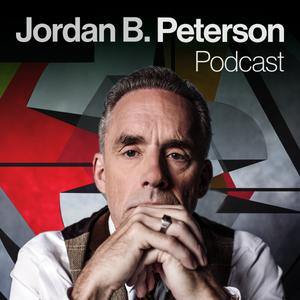 The Jordan B. Peterson Podcast
The Jordan B. Peterson Podcast
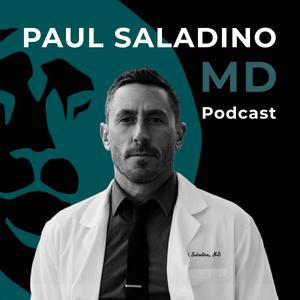 Paul Saladino MD podcast
Paul Saladino MD podcast
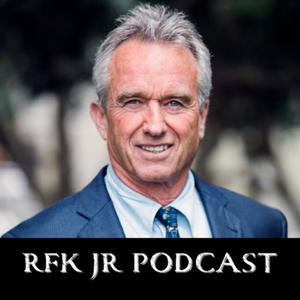 RFK Jr Podcast
RFK Jr Podcast
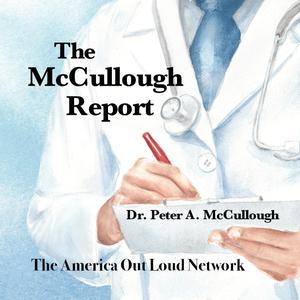 THE MCCULLOUGH REPORT
THE MCCULLOUGH REPORT
 Hay House Meditations
Hay House Meditations